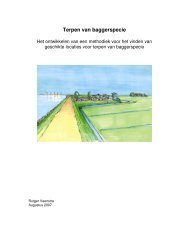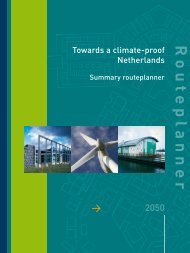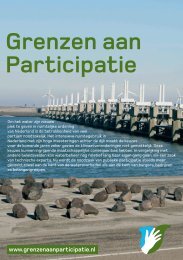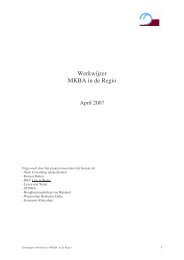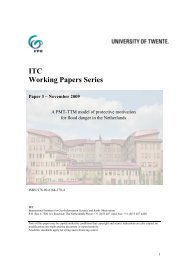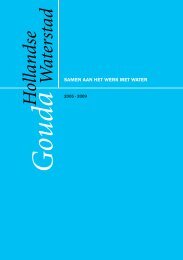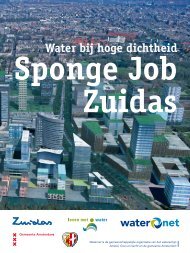Deltas on the move; Making deltas cope with the effects of climate c
Deltas on the move; Making deltas cope with the effects of climate c
Deltas on the move; Making deltas cope with the effects of climate c
- No tags were found...
Create successful ePaper yourself
Turn your PDF publications into a flip-book with our unique Google optimized e-Paper software.
KvR report 001/2006Restorati<strong>on</strong> <strong>of</strong> sediment flow at damsReservoirs have been c<strong>on</strong>structed upstream in many rivers, trapping all <strong>the</strong> sedimentcarried al<strong>on</strong>g by <strong>the</strong> river. C<strong>on</strong>sequently, sediment is no l<strong>on</strong>ger transported to <strong>the</strong>delta. Well-known examples are <strong>the</strong> Nile and <strong>the</strong> Colorado. Due to <strong>the</strong> lack <strong>of</strong>sediment, <strong>the</strong>se <strong>deltas</strong> are receding by tens <strong>of</strong> meters per year. In most cases,breaking down <strong>the</strong> dams is not an opti<strong>on</strong>. Methods or technologies could <strong>the</strong>reforebe sought to let <strong>the</strong> sediment pass through while still keeping <strong>the</strong> dams in place.Restorati<strong>on</strong> <strong>of</strong> sediment balance <strong>of</strong> streams and riversThe sediment balance has been disturbed in many drainage basins by fixing <strong>the</strong>locati<strong>on</strong> <strong>of</strong> streams and river beds. Erosi<strong>on</strong> has thus been checked, butsedimentati<strong>on</strong> c<strong>on</strong>tinues at <strong>the</strong> same level. C<strong>on</strong>sequently, many naturally erodingstream and river beds now have a sedimentati<strong>on</strong> surplus. The result is that <strong>the</strong>seriver beds gradually silt up, leaving less room for <strong>the</strong> storage <strong>of</strong> high water. At <strong>the</strong>same time, less sediment reaches <strong>the</strong> delta, resulting in a shortage <strong>of</strong> sediment.Where possible, opti<strong>on</strong>s must be sought in river and stream systems to restore <strong>the</strong>process <strong>of</strong> erosi<strong>on</strong>.<str<strong>on</strong>g>Deltas</str<strong>on</strong>g> <strong>on</strong> <strong>the</strong> <strong>move</strong>4.4 SummaryFour strategies <strong>of</strong> system-based measures can be distinguished: physical measuresaimed at <strong>the</strong> management <strong>of</strong> sediment and water, adaptati<strong>on</strong> and no acti<strong>on</strong>. Theextent to which measures could c<strong>on</strong>tribute to <strong>the</strong> c<strong>on</strong>tinued existence <strong>of</strong> <strong>deltas</strong> ispartly dependent <strong>on</strong> <strong>the</strong> space and s<strong>cope</strong> available <strong>with</strong>in a given delta. Whichmeasure can best be taken depends <strong>on</strong> local ecological, ec<strong>on</strong>omic and socialcircumstances.In densely populated <strong>deltas</strong>, it will be difficult to take system-based measures thatrequire a lot <strong>of</strong> space. In <strong>the</strong> case <strong>of</strong> many <strong>deltas</strong> in poor countries, where <strong>the</strong> costsare much greater than <strong>the</strong> benefits, it may be an opti<strong>on</strong> not to take physicalmeasures at all. Spatial planning is <strong>the</strong>n a way <strong>of</strong> adaptati<strong>on</strong> in which different z<strong>on</strong>esin a delta are identified by which <strong>the</strong> spatial distributi<strong>on</strong> <strong>of</strong> people and humanactivities is regulated. At last political measures (gradually removing <strong>the</strong> populati<strong>on</strong>from <strong>the</strong> delta ) and/or ec<strong>on</strong>omic measures (insurance, compensati<strong>on</strong> for losses) canbe applied. Even if <strong>deltas</strong> cannot be fully protected by system-based measures, thiscan still be a suitable localized soluti<strong>on</strong>.By means <strong>of</strong> a careful, shallow method <strong>of</strong> gravel extracti<strong>on</strong>, <strong>the</strong> Border Meuse isregaining a broad, natural floodplain al<strong>on</strong>g a 35 km stretch <strong>of</strong> <strong>the</strong> river <strong>on</strong> <strong>the</strong> borderbetween <strong>the</strong> Ne<strong>the</strong>rlands and Belgium (Figure 4.6). As <strong>the</strong> river is no l<strong>on</strong>ger fixed inplace, <strong>the</strong> river’s eroding character is preserved and <strong>the</strong> created space will not befilled up again <strong>with</strong> sediment; instead, this sediment will be carried fur<strong>the</strong>rdownstream.Figure 4.6:The Border Meuse (Drawing by Jeroen Helmer).4041



